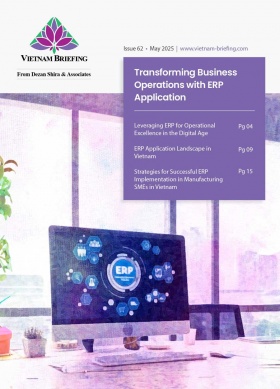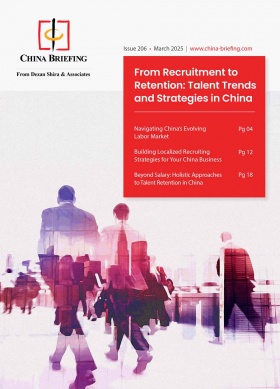China’s January-April 2025 FDI Data: Trends, Sectoral and Regional Analysis
China’s foreign direct investment (FDI) performance in January–April 2025 reflects a complex investment landscape: while new foreign-invested enterprise registrations surged to a record high, actual FDI inflows declined by 10.9 percent. This article analyzes the underlying trends, sectoral highlights, and regional shifts—offering insights into how China is navigating global uncertainties, advancing high-value industries, and recalibrating its appeal to multinational investors.
In the first four months of 2025, China’s FDI landscape painted a nuanced picture of resilience amid global headwinds. While the country welcomed a record‑high 18,832 newly registered foreign‑invested enterprises (up 12.1 percent year‑on‑year) the total actual use of foreign capital slipped to RMB 320.78 billion, a 10.9 percent decline.
This apparent divergence between firm registrations and funded investment brings out the complexity of today’s cross‑border investment environment, shaped by shifting supply chains, geopolitical tensions, and an evolving policy toolbox at home.
Against the backdrop of an uneven global FDI recovery, China’s performance from January through April 2025 offers a window into its strategic pivot toward high‑value sectors and deeper integration with key trading partners. From explosive growth in e‑commerce and aerospace manufacturing to robust inflows from Japan, Switzerland and other leading investor economies, the early‑year data reveal both opportunities and challenges for policymakers and multinationals alike.
This article unpacks the key trends, regional patterns, and policy drivers behind China’s FDI figures, and considers what they signal for the remainder of 2025.
Snapshot: China’s FDI data, Jan–Apr 2025
- RMB 320.8 billion in actual foreign investment (- 10.9% y‑o‑y)
- 18,832 new foreign‑invested enterprises registered (+ 12.1% y‑o‑y)
Sector highlights:
- Services dominate with RMB 231.3 billion (US$32.24 billion)
- Manufacturing attracted RMB 84.1 billion (US$11.72 billion)
- High‑Tech industries drew RMB 96.7 billion (US$13.47 billion)
Top performing high-tech industries are:
- E‑commerce services (+ 137%)
- Aerospace equipment (+ 86.2%)
- Chemical pharmaceuticals (+ 57.8%)
- Medical instruments (+ 4.9%)
Top investor growth rates:
- Japan: + 74.2%
- Switzerland: + 68.4%
- UK: + 54.6%
- ASEAN: + 42.9%
- South Korea: + 22.3%
- Germany: + 12.3%
*All data refer to actual use of foreign capital, including flows via free‑trade zones.
China’s January-April 2025 FDI data overview and overall trends
China’s FDI picture in the opening four months of 2025 offers a study in contrasts. On the one hand, the country continued to draw significant foreign interest, registering 18,832 new foreign‑invested enterprises—a healthy 12.1 percent uptick from the same period last year.
This surge in company formations speaks to multinational confidence in China’s large domestic market, improving business regulations and ongoing commitments to liberalization. On the other hand, the total actual use of foreign capital eased to RMB 320.78 billion (US$44.72 billion), down 10.9 percent year‑on‑year, as global economic uncertainty and tighter financial conditions prompted investors to deploy funds more selectively.
Beneath these headline figures lies a rebalancing of sectoral priorities. The services sector retained its dominance, attracting over two‑thirds of all new inflows, while manufacturing, long the backbone of China’s FDI appeal, continued to draw sizeable commitments. Notably, high‑tech industries emerged as a clear growth engine, with nascent fields such as e‑commerce services, aerospace manufacturing and advanced pharmaceuticals seeing double‑ to triple‑digit percentage expansions. Early inflows from leading investors likewise reflected this quality shift: capital from Japan, Switzerland and the United Kingdom surged, while ASEAN partners deepened their engagement, underscoring China’s evolving role as both a manufacturing powerhouse and an innovation hub.
Together, these trends suggest that while foreign investors remain attracted to China’s scale and strategic location, they are increasingly channeling capital into high‑value segments and key regional gateways, laying the groundwork for more targeted growth in the months ahead.
Sectoral distribution
In the January-April period, foreign investors continued to view China’s services sector as the primary gateway to its vast consumer and business markets, channeling RMB 231.25 billion (US$32.34 billion; over two‑thirds of total FDI) into areas ranging from finance and logistics to retail and digital platforms. Manufacturing remained a steadfast pillar, with RMB 84.06 billion (US$ 11.83 billion) in fresh capital directed toward both traditional industries and advanced production chains.
Yet it is the high‑tech realm where the most dynamic growth occurred. Collectively, high‑tech industries attracted RMB 96.71 billion (US$13.48 billion), driven by a remarkable 137 percent surge in e‑commerce services as global retailers and platforms double‑down on China’s digital consumer base. Aerospace equipment manufacturing saw an 86.2 percent uptick, reflecting accelerating partnerships around the next generation aircraft and components.
Chemical pharmaceuticals benefited from a 57.8 percent boost, as overseas drugmakers forged R&D and production alliances. Even more modest gains (4.9 percent) in medical instruments and apparatus signal continued confidence in China’s evolving healthcare ecosystem.
Trends by source country
Regional and national origins of FDI reveal both deepening ties and shifting balances. Under the Regional Comprehensive Economic Partnership (RCEP) framework, ASEAN investors expanded their China stakes by 42.9 percent, tapping into integrated supply chains and geographic proximity. Among traditional heavyweights, Japan led the pack with a 74.2 percent surge, followed closely by Switzerland at 68.4 percent, underscoring renewed enthusiasm for Chinese manufacturing hubs and free‑trade zones.
The United Kingdom climbed 54.6 percent, buoyed by financial‑services and green‑tech collaborations, while South Korea (up 22.3 percent) and Germany (up 12.3 percent) continued to diversify their investments into high‑value segments, such as electric‑vehicle supply chains and advanced machinery.
European recalibration: Implications for China’s FDI outlook
While official figures show a record number of newly registered foreign-invested enterprises, data from the European Chamber’s Business Confidence Survey 2025 reveals deepening hesitation around capital commitment and long-term planning.
Confidence in China as a core investment destination remains subdued. Only 17 percent of surveyed European firms ranked China among their top current investment destinations—a marginal two-percentage-point increase from 2024 but still the second-lowest level ever recorded. Even more striking, just 12 percent consider China a future investment priority, a record low. Nearly one in five respondents no longer place China among their top 10 markets, matching the highest level in the survey’s history.
This sentiment stands in stark contrast to China’s surge in new foreign enterprise registrations, suggesting that while European firms are still entering or expanding presence, many are hedging against deeper financial exposure.
The survey also highlights a shift in reinvestment behavior. While 75 percent of European firms intend to reinvest China-earned profits in 2025—steady from the previous year—37 percent plan to do so at a level below their historical average. This pullback in reinvestment value compounds the decline in fresh capital injections and signals a more cautious approach to resource allocation.
Taking all into account, it’s clear that many European companies are reassessing new capital injections while continuing to invest in operations already generating returns. To reverse this trend, Chinese policymakers and local governments are expected to step up efforts to enhance transparency, regulatory predictability, and market access—particularly in high-value sectors where European firms maintain a competitive edge, such as advanced manufacturing, renewable energy, healthcare, and industrial services. The road ahead will be shaped by how effectively China addresses investor concerns while leveraging its industrial scale, innovation capacity, and expanding consumer market.
China’s ongoing efforts to stabilize FDI
On June 13, 2025, the Information Office of The State Council held a press conference, during which the deputy representative for international trade negotiations at the Ministry of Commerce (MOFCOM) answered questions from reporters on how China will further expand its high-level opening up and continue to support foreign investment in the country.
In 2025, China has intensified its efforts to stabilize and attract foreign direct investment through a combination of expanded market access, policy upgrades, and institutional reforms. These initiatives are designed to bolster investor confidence, facilitate reinvestment, and guide capital toward strategic growth sectors.
Expanding market access and sectoral openness
A key pillar of China’s FDI strategy is the expansion of market access in high-potential industries. The MOFCOM, in coordination with other departments, will accelerate pilot programs in cloud computing, biotechnology, and wholly foreign-owned hospitals. These initiatives, already under implementation, aim to unlock new opportunities in fields where foreign players bring cutting-edge expertise and strong international linkages.
In parallel, China is steadily advancing the broader liberalization of its services sector. Though still under phased development, this effort signals Beijing’s commitment to allowing deeper participation of foreign enterprises across a wider range of services, ultimately enhancing the global competitiveness of its domestic market.
Optimizing the policy support framework
To further direct investment into priority areas, China is revising and expanding its Catalogue of Encouraged Industries for Foreign Investment. While the final updated catalogue is yet to be released, the process is underway and seeks to provide clearer guidance for foreign firms looking to align their strategies with China’s economic and industrial policy goals—especially in emerging and future-oriented sectors.
At the same time, the government is actively studying policies to support domestic reinvestment by foreign-invested enterprises. This includes reducing barriers and costs associated with reinvesting profits earned in China. Though still in the research and consultation phase, such measures aim to increase the stickiness of FDI by encouraging long-term capital commitment and strengthening industry cluster effects.
Moving from planning to implementation
China’s 2025 Action Plan for Stabilizing Foreign Investment has already moved into the implementation stage. As part of this, MOFCOM has committed to coordinating across ministries to ensure alignment and execution. Several of the high-profile pilot programs mentioned above are operational or in pilot rollout, signaling a shift from policy intent to real-world application.
Through these combined efforts, China is signaling its intention to maintain a competitive investment environment amid shifting global dynamics. With global investors facing increasing complexity in capital allocation, China’s strategy focuses on enhancing transparency, reducing uncertainty, and offering meaningful opportunities in sectors aligned with long-term development goals. Again, whether these measures succeed in reversing recent declines in actual FDI inflows will depend on timely implementation, improved communication with foreign stakeholders, and continued commitment to structural reform.
About Us
China Briefing is one of five regional Asia Briefing publications, supported by Dezan Shira & Associates. For a complimentary subscription to China Briefing’s content products, please click here.
Dezan Shira & Associates assists foreign investors into China and has done so since 1992 through offices in Beijing, Tianjin, Dalian, Qingdao, Shanghai, Hangzhou, Ningbo, Suzhou, Guangzhou, Haikou, Zhongshan, Shenzhen, and Hong Kong. We also have offices in Vietnam, Indonesia, Singapore, United States, Germany, Italy, India, and Dubai (UAE) and partner firms assisting foreign investors in The Philippines, Malaysia, Thailand, Bangladesh, and Australia. For assistance in China, please contact the firm at china@dezshira.com or visit our website at www.dezshira.com.
- Previous Article China Clarifies Safe Harbor Rules for Price Resale Agreements – New Draft Amendment
- Next Article








